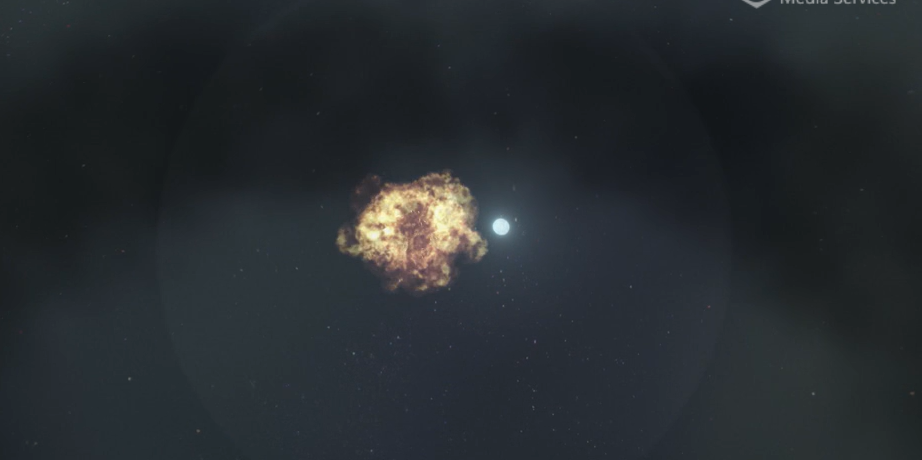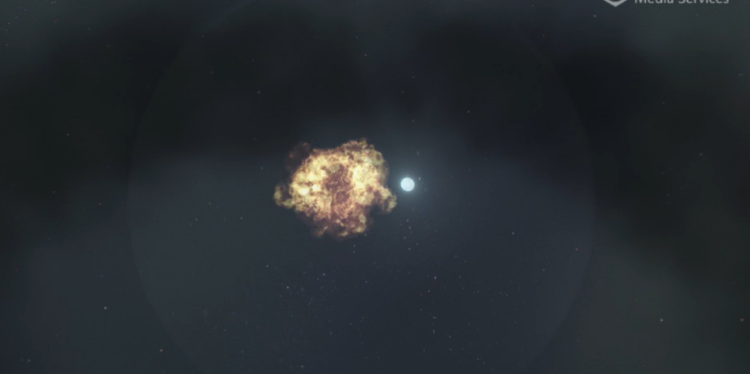In the latest issue of the journal Nature, astronomers from Stockholm University reveal the origin of a thermonuclear supernova explosion. Strong emission lines of helium and the first detection of such a supernova in radio waves show that the exploding white dwarf star had a helium-rich companion.

Credit: Adam Makarenko/W. M. Keck Observatory
In the latest issue of the journal Nature, astronomers from Stockholm University reveal the origin of a thermonuclear supernova explosion. Strong emission lines of helium and the first detection of such a supernova in radio waves show that the exploding white dwarf star had a helium-rich companion.
Supernovae of Type Ia are important for astronomers since they are used to measure the expansion of the Universe. However, the origin of these explosions has remained an open question. While it is established that the explosion is that of a compact white dwarf star somehow accreting too much matter from a companion star, the exact process and the nature of the progenitor is not known. The new discovery of supernova SN 2020eyj established that the companion star was a helium star that had lost much of its material just prior to the explosion of the white dwarf.
“Once we saw the signatures of strong interaction with the material from the companion we tried to also detect it in radio emission”, explains Erik Kool, post-doc at the Department of Astronomy at Stockholm university and lead author of the paper. “The detection in radio is the first one of a Type Ia supernova – something astronomers have tried to do for decades.”
Supernova 2020eyj was discovered by the Zwicky Transient Facility camera on Palomar mountain, where the Oskar Klein Centre at Stockholm University are members.
“The Nordic Optical telescope on La Palma was fundamental for following up this supernova”, says Professor Jesper Sollerman at the Department of Astronomy and co-author of the paper.
“As were spectra from the large Keck telescope on Hawai’i that immediately revealed the very unusual helium-dominated material around the exploded star.”
“This is clearly a very unusual Type Ia supernova, but still related to the ones we use to measure the expansion of the universe”, adds Joel Johansson from the Department of Physics.
“While normal Type Ia supernovae appear to always explode with the same brightness, this supernova tells us that there are many different pathways to a white dwarf star explosion”, he adds.
Link to the article in Nature: https://www.nature.com/articles/s41586-023-05916-w
The paper A radio-detected Type Ia supernova with helium-rich circumstellar material is published in Nature and is led by Erik Kool from the Department of Astronomy at Stockholm University and describes the first radio detection of a Type Ia supernova. Co-authors from Stockholm University are Joel Johansson, Jesper Sollerman, Steve Schulze, Peter Lundqvist, Sheng Yang, and Conor Omand. This work involved researchers from institutes across the world, including Caltech, Weizmann Institute, IAA-CSIC, NAOJ, Macquarie University, and Trinity College Dublin.
Journal
Nature
DOI
10.1038/s41586-023-05916-w
Method of Research
Observational study
Subject of Research
Not applicable
Article Title
A radio-detected Type la supernova with helium-rich circumstellar material
Article Publication Date
17-May-2023





